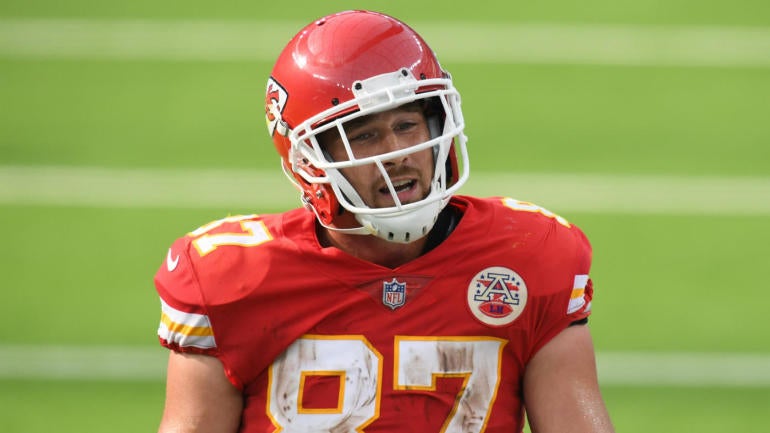
The devil is in the details when it comes to NFL player contracts because the deals aren't fully guaranteed like in MLB and the NBA. This makes contract structure extremely important. Without a structure that protects the player so there's some level of real security, NFL contracts are barely worth the paper used to print them.
The compensation in the early years of a multiyear deal is useful in determining whether a contract is front loaded or back loaded. Since NFL contracts are essentially a series of one-year team options once the guarantees run out, it's crucial for a player to avoid a back-loaded deal with more money in the latter years than the early years. Back-loaded contracts are considered team friendly deals.
Here's look at six contracts signed in 2020 I've identified as being flawed for various reasons. A couple of the contracts aren't quite what they seem to be after close inspection. Quite frankly, a couple of the other contracts never should have been done.
George Kittle spearheaded a long overdue reset of a stagnant tight end market in August with the five-year, $75 million contract extension averaging $15 million per year he received from the 49ers. The deal has a player friendly structure. Kittle's $40 million in overall guarantees and $30 million fully guaranteed at signing are both the most ever in an NFL contract for a tight end.
Within a few hours of Kittle's deal being announced, Kelce signed a four-year, $57.25 million extension averaging $14,312,500 per year. The two deals couldn't be more different, although Kelce has $23 million in guarantees where $21 million was fully guaranteed at signing.
Kelce had two years remaining on his contract for $18.25 million, which was signed in 2016. His deal set to expire after the 2021 season. Kelce was in no danger of being released before the deal expired.
The Chiefs got an extremely team friendly structure. A "pay as you go" contract structure was used where a player's cash and salary cap numbers are the same in each contract year because there isn't a signing bonus that would be prorated over the life of the contract (for a maximum of five years).
Kelce isn't getting a raise this year, which is unusual for a deal of this magnitude. He is making the same $9.25 million in 2020 that was in his previous contract. Kelce is only receiving $4.25 million more over his remaining two years than if he played out the 2016 extension.
Surprisingly, Kelce has minimal guaranteed money after 2021. Only $2 million of his $6.5 million 2022 base salary, which was guaranteed for injury upon signing, becomes fully guaranteed that March on the third day of the league year. This entire $6.5 million really should become fully guaranteed next March on the third day of the 2021 league year.
The Chiefs have maximum salary cap flexible because of how Kelce's contract is structured. Should Kelce's skills rapidly start to diminish, Kansas City can exit the deal as early as 2022 without any salary cap consequences.
Kelce has $11.75 million of new money through his first new contract year of 2022. It would have been $11.65 million for Kansas City to designate Kelce as a franchise player in 2022 if he played out his contract, which would be 120 percent of his 2021 salary cap number. This assumes Kelce would have earned a $750,000 escalation of his 2021 base salary because of 2020 performance, just like he did for 2019 and this year.
Kelce has $25 million in new money over the first two new contract years (through 2023). The $25 million is $630,000 less than Kelce would have made playing under two straight franchise tags in 2022 and 2023.
Kelce didn't get enough money in his existing contract years or security to give up four years. The Chiefs essentially have four team options with Kelce starting in 2022, his first new contract year.
Kelce's contract is incredibly back loaded. His actual new money after each of the first three new contract years is $11.75 million, $25 million and $40 million. This equates to 20.5 percent, 43.7 percent and 69.8 percent of new money after the first, second and third new contract years.
At worst, Kelce's new money percentages should have matched a neutral deal, which is neither front loaded or back loaded. Under a neutral deal, Kelce's new money after these junctures should have been $14,312,500, $28.625 million and $42,937,500. In actuality, Kelce should have been approaching $21.25 million, $32.5 million and $44.125 million after each of the first three new contract years based on lucrative four year extensions for veteran players with two years remaining on a contract.
On the surface, Cooper becoming the NFL's second highest paid wide receiver by average yearly salary with a five-year, $100 million contract at $20 million per year to remain with the Cowboys seems impressive. It isn't the case when Cooper's deal is put into context.
Inexplicably, Cooper's deal wasn't structured as player friendly as the five year, $105 million contract defensive end DeMarcus Lawrence signed with the Cowboys last year as a franchise player.
As an unrestricted free agent, Cooper had the Washington Football Team, an NFC East rival, in hot pursuit. My sources have indicated that Washington was willing to make Cooper the league's highest paid pass catcher ahead of Falcons wide receiver Julio Jones' $22 million per year, which was the standard at that time, with a favorable structure. Although Cooper wanted to stay in Dallas, a savvy agent should have been able to leverage Washington's interest into a better structure than in Lawrence's deal.
Instead, Lawrence's third year salary in 2021 became fully guaranteed in March while Cooper's third year salary in 2022 doesn't become fully guaranteed until the fifth day of that league year. In other words, the third year guarantee for Lawrence vests a year earlier contractually than Cooper's.
It wouldn't matter as much if Cooper had gotten the same $25 million signing bonus as Lawrence because he would be better protected from a potential release in 2022 than with his $10 million signing bonus. If Cooper isn't producing or the Cowboys are confident that CeeDee Lamb can be a number one wide receiver, the Cowboys can pick up $16 million of salary cap space by releasing him in 2022 before the full guarantee is activated. Dallas would only have a $6 million cap charge from the remaining proration of Cooper's $10 million signing bonus.
By contrast, it's going to be much more difficult for Dallas to move on from Lawrence next offseason when entering the third year of his contract if he underperforms this season. The Cowboys will have a $32 million cap charge for releasing Lawrence next offseason unless a post-June 1 designation is used because his $17 million 2021 base salary is already fully guaranteed. The $32 million is $10 million more than Lawrence's actual 2021 cap number. Dallas would get some sort of cap relief because Lawrence's 2021 guarantee has an offset.
Cooper has a neutral deal, which shouldn't have been acceptable under the circumstances since he had immense leverage. Rather than having 20 percent, 40 percent and 60 percent of money after the first, second and third contract years, Cooper should have been able to get a better cash flow than Lawrence or wide receiver Dez Bryant did when franchised in 2015.
On average, the cash flow percentages of Lawrence and Bryant at these junctures were 30.9 percent, 45.7 percent and 62.9 percent. In other words, Cooper's cash flow should be $31 million, $46 million and $63 million, in a worst case scenario, after his first, second and third contract years. The cash flow in his actual deal is $20 million, $40 million and $60 million.
White signed a four-year, $69 million extension (worth a maximum of $70 million with incentives) making him the NFL's highest paid cornerback at $17.25 million per year about a week before the start of the regular season. The deal contained $55 million of guarantees where $37 million was fully guaranteed at signing.
Ordinarily, that would be great, but anyone could have seen White was leaving money on table because a Jalen Ramsey deal was forthcoming. Ramsey becoming the league's first $20 million per year cornerback seemed plausible since he was giving his agent, David Mulugheta, wide latitude to do what he felt was best instead of providing input during the negotiating process.
I've heard that White was eager to get a deal done before the first game of the season. Knowing that Ramsey was going to drastically change the cornerback market, patience should have been White's best friend. Unless White was micromanaging the negotiations, his representation should have been able to curb his instincts. That was my experience during my numerous years as an agent when I had an impatient client.
As expected, Ramsey got to the $20 million per year mark two days before the regular started. He signed a five-year, $100 million extension worth up to $105 million through salary escalators. Ramsey also set records for cornerbacks with $43.703 million fully guaranteed at signing and $71.203 in total guarantees.
White coming in at $17.25 million didn't do Ramsey any favors. It's conceivable that the base value of Ramsey's extension could have hit the $21 million per year without White's deal in the marketplace.
Ramsey's deal was done with enough time for White to benefit from it if he had waited. How much money White left on the table can be quantified.
Ravens cornerback Marlon Humphrey got the deal White was supposed to get if he had let Ramsey go first. Three weeks into the regular season, Humphrey signed a five-year, $97.5 million extension (worth a maximum of $98.75 million through incentives). There are approximately $67 million in guarantees with $40 million fully guaranteed at signing. It's hard to fathom White at $17.25 million per year while Ramsey and Humphrey's deals average $20 million and $19.5 million per year when he was the only one of three who was a consensus first team All-Pro last season.
Ngakoue made it abundantly clear he wasn't going to continue playing for the Jaguars after being designated as franchise player for $17.788 million. He wanted out Jacksonville so badly he put his money where his mouth is. In order to facilitate a trade to Minnesota, Ngakoue took over a 30 percent pay cut from his unsigned $17.788 million franchise tender. He is making $12 million to play this season for the Vikings.
Ngakoue borrowed the franchise player pay cut concept from edge rusher Jadeveon Clowney, who took approximately $1 million less when traded from the Texans to Seahawks shortly before the start of last season. Clowney was able to finagle a clause preventing the Seahawks from designating him as a franchise or transition player once his one-year contract expired.
Given how big of a haircut Ngakoue has taken financially, it's shocking that he didn't get a clause like Clowney preventing a franchise or transition designation during the offseason. The absence of this type of clause should have been a deal breaker for Ngakoue with such a sizable pay cut.
The financial hit Ngakoue is taking gets compounded because of the franchise tag calculations. In most cases a second franchise tag is a 20 percent raise over the initial designation. In Ngakoue's case, he stands to make roughly $27.5 million on two franchise tags instead of $39,123,600 if designated twice without the pay cut.
Ngakoue should regret that he didn't get a tag prohibition clause similar to Clowney's. He is currently tied for fourth in the NFL with five sacks and on pace for a career high of 13. Although the 2021 salary cap is expected to take a steep drop because of the coronavirus pandemic, Ngakoue likely would have been a hot commodity if assured of hitting the open market in the offseason. That's because players in their prime who can get consistent pressure on opposing quarterbacks and take them down are typically paid a premium in free agency.
Equally troubling is the long lasting ramifications for other franchise players Ngakoue's decisions may have. Ngakoue may have set a new precedent where a franchise player who is unhappy with his situation may have to take a steep pay cut where the acquiring team can still restrict him once his one year contract expires in order to get a change of scenery.
A Hunt contract extension wasn't at the top of anybody's radar screen because Nick Chubb was 47 yards away of winning the rushing title last year with 1,494 yards. Nonetheless, Hunt signed a two-year, $12 million extension (worth a maximum of $13.25 million through salary escalators) with $8.509 million of guarantees.
Strictly from a talent standpoint, Hunt fits in the same salary tier as Dalvin Cook, Derrick Henry, Alvin Kamara and Joe Mixon, who signed multiyear deals averaging between $12 million and $12.6 million since the middle of July. Technically, Kamara's deal averages $15 million, but he has no chance of seeing the $25 million in his 2025 contract year. Hunt won the NFL rushing title in 2017 with 1,327 yards while a member of the Chiefs as a rookie.
None of these players has baggage like Hunt. He is in the process of rebuilding his career after a physical altercation with a woman led to his release by Chiefs in 2018 and an eight-game suspension last season under the league's personal conduct policy.
The Browns have protected themselves in case Hunt has another misstep with the contract's structure. Approximately 75 percent of Hunt's compensation in 2021 and 2022 is in different roster bonuses. In each of these years, there's a training camp roster bonus, a week one of the regular season roster bonus, a per game roster bonus, which encompasses being on injured reserve or the physically unable to perform list, and an end of the regular season roster bonus.
Hunt is from the Cleveland area. He seemingly valued being near home and the Browns giving him a chance to resurrect his career. Chubb's right MCL sprain has given Hunt a chance showcase his skills despite being hindered by his own groin injury.
Running backs getting paid in free agency can be tricky, especially with a declining 2021 salary cap having a $175 million floor. We'll never know whether Hunt could have found a team willingly to pay him like Melvin Gordon or more in free agency because of the extension. Gordon signed a two-year, $16 million deal with the Broncos where $13.5 million was fully guaranteed in this year's free agency.
Slay quickly replaced Miami's Byron Jones as the league's highest-paid cornerback by average salary when he received a new three-year extension worth $50.05 million in March as a part of his trade from the Lions a couple of days after the start of the 2020 league year. Jones remained the benchmark in the other more important contract metrics.
Slay's contract is too backloaded. He has 65 percent of his new money through his second new contract year whereas he would have 66.7 percent in a neutral deal. Based on lucrative three-year extensions with one contract year remaining, Slay should have had roughly 70 percent through his second new contract year.
Slay should have had enough leverage in a trade to get a more favorable structure because my understanding is the Eagles weren't the only team interested in trading for him. He will be vulnerable in 2022 when his salary cap number is $19.75 million unless he continues to be a Pro Bowl caliber cornerback. Slay will be 31 at that time.

























